The Global Next Generation Solar Cell market size was valued at US$ 4.13 billion in 2024 and is expected to reach US$ 12.95 billion by 2031. The Next Generation Solar Cell market is estimated to record a CAGR of 15.73% from 2025 to 2031. The sustainability and green manufacturing are likely to remain a key trend in the market.
Next Generation Solar Cell Market Analysis
The Next-Generation Solar Cell market is gaining momentum, driven by a global push toward clean energy, innovation in photovoltaic technology, and evolving energy consumption patterns. One of the primary market drivers is the growing demand for high-efficiency, low-cost solar solutions. Next-gen technologies—such as perovskite, organic photovoltaic (OPV), and tandem solar cells—offer improved energy conversion rates, flexibility, and lightweight designs, making them attractive for a wide range of applications, from building-integrated photovoltaics to portable electronics. Rising environmental concerns and net-zero commitments are prompting governments and corporations to invest in advanced renewable energy technologies. Incentives, subsidies, and R&D funding across regions such as Europe, North America, and Asia-Pacific are accelerating the commercialization of emerging solar technologies.
Next Generation Solar Cell Market Overview
Next-generation solar cells represent the evolution of photovoltaic technology, offering higher efficiency, lower manufacturing costs, and greater versatility compared to traditional silicon-based solar panels. These advanced solar cells include technologies such as perovskite, organic photovoltaics (OPV), quantum dot, multi-junction, and thin-film cells. They are designed to overcome the limitations of conventional systems by delivering superior performance under varied lighting conditions, lightweight and flexible form factors, and potential integration into a wide range of surfaces and products. Additionally, the potential for lower production costs and easier scalability makes these technologies appealing for large-scale deployment. Companies are increasingly investing in R&D and forming strategic partnerships to commercialize next-gen solar solutions, backed by supportive government policies and sustainability mandates. As the global economy shifts toward cleaner energy and carbon-neutral goals, next-generation solar cells are positioned as a strategic asset—enabling businesses to innovate, reduce energy costs, and align with long-term environmental commitments.
Customize This Report To Suit Your Requirement
You will get customization on any report - free of charge - including parts of this report, or country-level analysis, Excel Data pack, as well as avail great offers and discounts for start-ups & universities
Next Generation Solar Cell Market: Strategic Insights
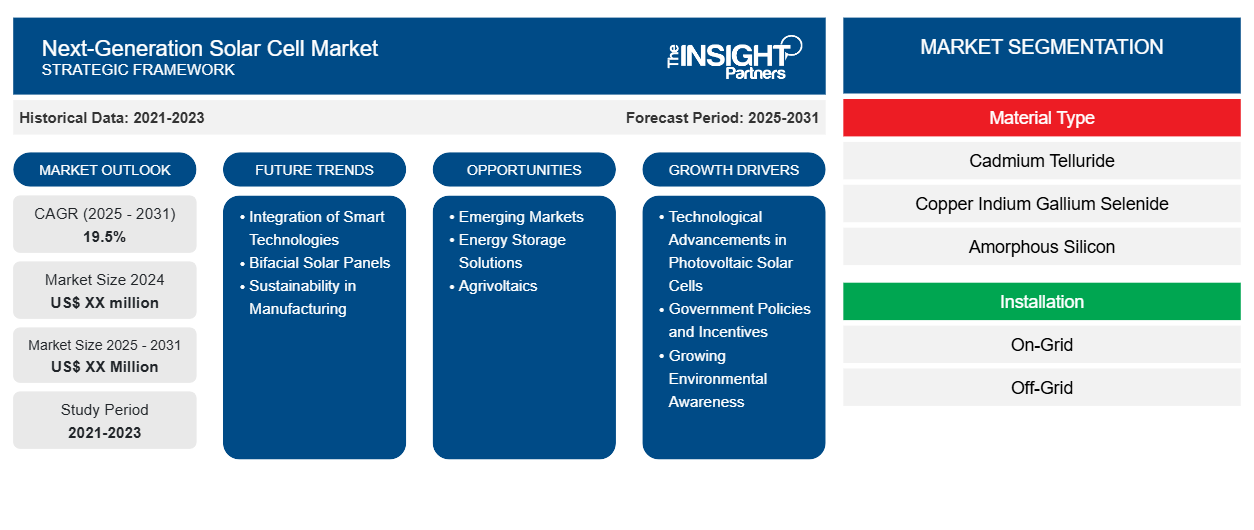
- Get Top Key Market Trends of this report.This FREE sample will include data analysis, ranging from market trends to estimates and forecasts.
You will get customization on any report - free of charge - including parts of this report, or country-level analysis, Excel Data pack, as well as avail great offers and discounts for start-ups & universities
Next Generation Solar Cell Market: Strategic Insights

- Get Top Key Market Trends of this report.This FREE sample will include data analysis, ranging from market trends to estimates and forecasts.
Next Generation Solar Cell Market Drivers and Opportunities
Growing Need for Lightweight and Flexible Solutions to Favor Market
The demand for lightweight and flexible solar technologies is rapidly growing as industries look to integrate renewable energy into non-traditional, mobile, and space-constrained applications. Conventional silicon-based solar panels are rigid, heavy, and limited in form factor, which restricts their usability in sectors such as aerospace, automotive, consumer electronics, and construction. Next-generation solar cells—particularly thin-film, organic photovoltaics (OPVs), and perovskite-based cells—offer significant advantages. These technologies can be manufactured on lightweight, flexible substrates such as plastic, glass, or metal foils, making them ideal for curved or moving surfaces. For instance, in aerospace and drone technology, weight is a critical factor. Ultra-light solar films help extend flight time and power on-board systems without adding significant mass. In the automotive sector, flexible solar panels are being integrated into vehicle rooftops and windows to charge batteries and power in-car systems, supporting the growing push toward energy-efficient electric vehicles (EVs). Similarly, in consumer electronics, flexible solar materials enable the creation of energy-harvesting wearables, sensors, and mobile devices.
Rising Global Energy Demand and Electrification
The global shift toward electrification is accelerating rapidly, driven by the widespread adoption of electric vehicles (EVs), smart homes, industrial automation, and expanding urban infrastructure. This transformation is creating an unprecedented demand for clean, reliable, and decentralized sources of electricity. Traditional energy systems, often reliant on fossil fuels and centralized grids, are increasingly inadequate in meeting the dynamic and distributed energy needs of modern economies. Next-generation solar technologies are emerging as a vital solution to this challenge. Unlike conventional panels, advanced solar cells—such as perovskite, organic photovoltaics (OPVs), and tandem cells—offer higher efficiency, flexible integration, and scalability, making them ideal for diverse use cases. They can be deployed across rooftops, vehicles, infrastructure, and mobile devices, supporting a decentralized energy model that reduces grid dependency and transmission losses.
Next Generation Solar Cell Market Report Segmentation Analysis
Key segments that contributed to the derivation of the Next Generation Solar Cell market analysis are material type, installation type, and end user
- Based on material type, the market is segmented into Cadmium Telluride (Cdte), Copper Indian Gallium Selenide (CIGS), Perovskite, Nanomaterials, and Others.
- On the basis of installation type, the market is bifurcated into On-Grid, and Off-Grid.
- Based on end user, the market is segmented into Residential, Commercial, and Industrial.
Next Generation Solar Cell Market Share Analysis by Geography
The geographic scope of the Next Generation Solar Cell market report is mainly divided into five regions: North America, Europe, Asia Pacific, Middle East and Africa, South and Central America.
Asia Pacific dominated the market in 2024. The Asia-Pacific region is emerging as a key growth hub for the next-generation solar cell market, driven by strong policy support, rapid industrialization, and the region’s growing energy demand. Governments across countries like China, India, Japan, South Korea, and Australia are actively investing in renewable energy infrastructure to reduce dependency on fossil fuels and meet aggressive decarbonization targets. China, in particular, leads global solar manufacturing and is heavily investing in advanced solar technologies such as perovskite and tandem cells to maintain its market dominance. India is also expanding its solar capacity rapidly, creating opportunities for high-efficiency, low-cost next-gen cells that suit its climate and grid needs. Meanwhile, Japan and South Korea are leveraging innovation in organic and thin-film solar technologies to support domestic energy needs and export-led growth. Urbanization, rising electrification, and the push for energy access in rural and remote areas are driving demand for lightweight, flexible, and decentralized solar solutions. Next-gen cells are ideal for these applications, including rooftop systems, mobile devices, and building-integrated photovoltaics (BIPV). Additionally, the region’s strong electronics and automotive industries create natural synergies with advanced solar technologies, particularly for integration into EVs and consumer devices. These factors collectively position Asia-Pacific as a major engine of innovation and adoption in the next-gen solar cell market.
Next Generation Solar Cell Market Regional Insights
The regional trends and factors influencing the Next Generation Solar Cell Market throughout the forecast period have been thoroughly explained by the analysts at The Insight Partners. This section also discusses Next Generation Solar Cell Market segments and geography across North America, Europe, Asia Pacific, Middle East and Africa, and South and Central America.
Next Generation Solar Cell Market Report Scope
| Report Attribute | Details |
|---|---|
| Market size in 2024 | US$ 4.13 Billion |
| Market Size by 2031 | US$ 12.95 Billion |
| Global CAGR (2025 - 2031) | 15.73% |
| Historical Data | 2021-2023 |
| Forecast period | 2025-2031 |
| Segments Covered |
By Material Type
|
| Regions and Countries Covered | North America
|
| Market leaders and key company profiles |
|
Next Generation Solar Cell Market Players Density: Understanding Its Impact on Business Dynamics
The Next Generation Solar Cell Market is growing rapidly, driven by increasing end-user demand due to factors such as evolving consumer preferences, technological advancements, and greater awareness of the product's benefits. As demand rises, businesses are expanding their offerings, innovating to meet consumer needs, and capitalizing on emerging trends, which further fuels market growth.
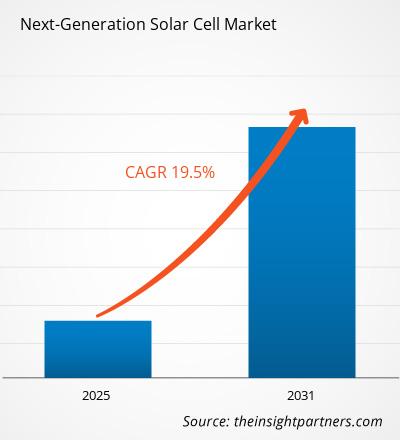
- Get the Next Generation Solar Cell Market top key players overview
Next Generation Solar Cell Market News and Recent Developments
The Next Generation Solar Cell market is evaluated by gathering qualitative and quantitative data post primary and secondary research, which includes important corporate publications, association data, and databases. A few of the developments in the Next Generation Solar Cell market are listed below:
- Hanwha Systems announced that its in-house venture, Flexell Space, has signed a Letter of Intent (LOI) with Airbus Defence and Space GmbH for a collaboration on the development of next-generation space solar cell modules using tandem solar cells. Through this agreement, Flexell Space and Airbus plan to design and develop space solar cell modules that are more than 50% lighter than existing models, while maintaining equivalent performance and efficiency. (Source: Hanwha Systems, Press Release, August 2024)
- Navitas Solar, a Surat based leading module manufacturing brand in the India with manufacturing capacity of 2 GW p.a. launches its latest next generation N-Type TOPCon modules at The Smarter E India – Intersolar India 2024. N-type TOPCon technology is well known for its remarkable energy yield and low temperature coefficient and improves the overall efficiency and lifespan of the solar modules. (Source: Navitas Solar, Press Release, February 2024)
Next Generation Solar Cell Market Report Coverage and Deliverables
The “Next Generation Solar Cell Market Size and Forecast (2021–2031)” report provides a detailed analysis of the market covering below areas:
- Next Generation Solar Cell market size and forecast at global, regional, and country levels for all the key market segments covered under the scope
- Next Generation Solar Cell market trends as well as market dynamics such as drivers, restraints, and key opportunities
- Detailed PEST/Porter’s Five Forces and SWOT analysis
- Next Generation Solar Cell market analysis covering key market trends, global and regional framework, major players, regulations, and recent market developments
- Industry landscape and competition analysis covering market concentration, heat map analysis, prominent players, and recent developments for the Next Generation Solar Cell market
- Detailed company profiles
Frequently Asked Questions
What are the future trends of the Next Generation Solar Cell market?
Which region dominated the Next Generation Solar Cell market in 2024?
What are the driving factors impacting the Next Generation Solar Cell market?
Which are the leading players operating in the Next Generation Solar Cell market?
What would be the estimated value of the Next Generation Solar Cell market by 2031?
What is the expected CAGR of the Next Generation Solar Cell market?
- Historical Analysis (2 Years), Base Year, Forecast (7 Years) with CAGR
- PEST and SWOT Analysis
- Market Size Value / Volume - Global, Regional, Country
- Industry and Competitive Landscape
- Excel Dataset
Recent Reports
Related Reports
Testimonials
Reason to Buy
- Informed Decision-Making
- Understanding Market Dynamics
- Competitive Analysis
- Identifying Emerging Markets
- Customer Insights
- Market Forecasts
- Risk Mitigation
- Boosting Operational Efficiency
- Strategic Planning
- Investment Justification
- Tracking Industry Innovations
- Aligning with Regulatory Trends












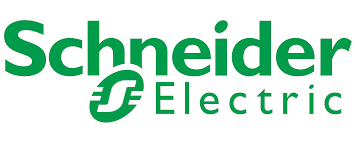



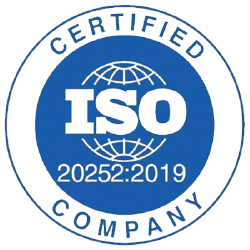
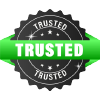



 Get Free Sample For
Get Free Sample For